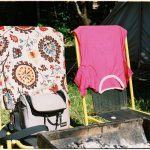If your sofa or chair cushions sag or feel uneven, it’s likely your upholstery springs need fixing. Start by carefully removing the fabric and inspecting for broken or loose springs using pliers to adjust or replace them. Secure springs with twine or clips, and add padding if needed before reattaching the fabric. Regular inspections and rotating cushions can prolong spring life. Follow these steps, and you’ll soon restore comfort and support to your furniture while learning how to keep it strong longer.
Table of Contents
Key Takeaways
- Identify sagging or uneven cushions indicating worn or broken upholstery springs needing repair or replacement.
- Carefully remove upholstery fabric using a staple remover and label pieces for easy reassembly.
- Use pliers to straighten or replace broken springs with matching new ones, securing them with hog rings or twine.
- Reassemble fabric with heavy-duty thread and add foam padding for improved comfort and support.
- Regularly inspect springs, rotate cushions, and avoid sitting on edges to maintain spring integrity and prevent future sagging.
Identifying Common Signs of Worn or Broken Upholstery Springs
You’ll often notice three key signs when upholstery springs are worn or broken: sagging cushions, uneven support, and unusual noises like creaking or popping.
When you sit down, if the cushion sinks more than usual or feels less firm, that’s a clear indicator.
Uneven support might make you feel like you’re tilting or leaning to one side, which happens when some springs lose tension or break.
Feeling off-balance? It could be worn or broken springs causing uneven support in your upholstery.
Pay attention to any strange sounds when you shift your weight; those creaks and pops often come from springs struggling to hold up.
Spotting these signs early helps you avoid further damage and discomfort.
Tools and Materials Needed for Spring Repair
Successful upholstery spring repair requires having the right tools and materials on hand. Before you start, gather everything you’ll need to make the process smooth and efficient.
Having these items ready guarantees you won’t have to stop midway to search for supplies.
Here’s what you’ll want to prepare:
- Upholstery springs or spring replacement clips
- Pliers and wire cutters
- Upholstery twine or hog rings with pliers
- Heavy-duty needle and strong upholstery thread
- Foam padding or burlap for cushioning
With these tools, you’ll be equipped to handle the typical issues that come with sagging or broken springs.
Keeping your workspace organized with these essentials will help you focus on restoring comfort and support to your furniture.
How to Remove Upholstery Fabric Safely
Before repairing springs, carefully remove the upholstery fabric to avoid damage. Start by inspecting the fabric for staples, tacks, or nails holding it in place. Use a staple remover or flat-head screwdriver to gently pry them up. Work slowly to prevent tearing. Label each piece of fabric as you remove it to help with reassembly. Keep tools organized and note any fabric folds or pleats.
| Step | Tool Needed | Tip |
|---|---|---|
| Locate fasteners | Flashlight | Good lighting reveals staples |
| Remove staples | Staple remover | Pry gently to avoid tearing |
| Label fabric | Masking tape/marker | Keeps track of fabric placement |
| Detach fabric | Flat-head screwdriver | Slide under staples carefully |
| Store fabric | Clean surface | Prevents dirt and wrinkles |
Techniques for Repairing or Replacing Broken Springs
Although fixing broken upholstery springs can seem intimidating, understanding the right techniques makes the process manageable.
Fixing broken upholstery springs is easier than you think with the right approach and techniques.
First, identify which springs are broken by pressing and listening for creaks or feeling sagging areas. Then, decide whether to repair or replace the springs based on damage severity.
When repairing:
- Use pliers to straighten bent springs.
- Tighten loose springs by reattaching them securely.
- Replace broken springs with new ones of matching size and tension.
- Secure new springs with heavy-duty twine or spring clips.
- Test the repaired area by pressing to verify even tension and comfort.
Reinforcing Springs to Prevent Future Sagging
Preventing future sagging starts with reinforcing your upholstery springs properly. First, secure loose springs using heavy-duty upholstery twine or spring clips to keep them tightly in place.
You’ll want to add additional support by attaching a layer of jute webbing or burlap beneath the springs; this distributes weight evenly and reduces strain.
Consider installing extra springs in areas that bear the most pressure to provide balanced support. When tightening springs, make sure they’re taut but not overstretched to avoid premature wear.
Finally, inspect your spring system regularly and address any signs of weakening promptly. By reinforcing your springs with these steps, you’ll extend the life of your furniture and keep it comfortable for years to come.
Reassembling the Upholstery for a Clean Finish
Now that the springs are secure, focus on aligning the fabric seamlessly to avoid wrinkles or puckers.
Make sure the padding is evenly secured to maintain comfort and shape.
Finally, reattach the trim neatly to give your upholstery a polished, professional look.
Aligning Fabric Seamlessly
When you start reassembling the upholstery, take care to align the fabric seams precisely to verify a clean, professional finish. Misaligned seams can make your repair look sloppy and draw unwanted attention.
Here’s how to ascertain seamless fabric alignment:
- Lay the fabric flat and smooth out wrinkles before positioning.
- Match pattern repeats or texture direction carefully.
- Pin or clip seams temporarily to hold fabric in place.
- Use a staple gun or upholstery tacks to secure fabric starting from the center outward.
- Double-check seam alignment before final fastening.
Taking these steps will help you achieve that polished look, making your sofa or chair look as good as new once reupholstered.
Precision now saves you from frustration later.
Securing Padding Evenly
Although securing the padding evenly can seem tricky, it’s crucial for a smooth, professional upholstery finish.
Start by laying the padding flat over the springs, making sure it covers the entire frame without bunching. Use a staple gun or upholstery tacks to fix the padding in place, beginning in the center and working your way out to avoid wrinkles.
Keep tension consistent to prevent lumps or sagging later on. If you notice uneven areas, gently adjust the padding before securing more staples.
Pay special attention to corners and edges, making sure they’re snug but not stretched too tight. Taking your time here guarantees the final fabric layer sits perfectly smooth, giving your sofa or chair a refreshed, polished look.
Reattaching Trim Neatly
Before reattaching the trim, make certain all padding and fabric layers are smooth and securely in place. This prevents lumps and wrinkles, giving your upholstery a professional look.
Use these tips to reattach trim neatly:
- Align the trim carefully with the fabric edges to avoid gaps.
- Use a staple gun or upholstery tacks, spacing them evenly.
- Pull the trim taut but don’t overstretch to maintain shape.
- Trim excess fabric for a clean edge before securing.
- Check for any loose ends and tuck them under before finishing.
Taking your time here guarantees the upholstery looks crisp and polished. Neatly reattached trim not only enhances appearance but also prolongs the repair’s durability, making your sofa or chair look refreshed and sturdy.
Tips for Maintaining Upholstery Springs Over Time
To keep your upholstery springs in good shape, you’ll want to regularly inspect them for signs of wear or damage. Check for sagging, broken coils, or loose attachments.
Rotate cushions frequently to distribute weight evenly, reducing strain on springs. Avoid sitting on the sofa edges, which can stress the frame and springs.
Keep your furniture clean and dry; moisture leads to rust and weakens springs. If you notice squeaking, apply a small amount of lubricant to metal parts.
Tighten any loose screws or clips promptly to prevent further damage. By staying proactive with these simple steps, you’ll extend the life of your upholstery springs and keep your sofa or chair comfortable and supportive for years.
Frequently Asked Questions
Can Upholstery Springs Be Repaired Without Removing the Fabric?
You can sometimes repair upholstery springs without removing fabric by accessing them through the bottom or side. However, it’s often tricky, and removing fabric usually gives better results and easier access to fix the springs properly.
How Long Does a Typical Upholstery Spring Repair Take?
You’ll usually spend about one to three hours repairing upholstery springs, depending on the damage. If you’re experienced, it might be quicker, but be patient—rushing can cause more issues later on.
Are There Eco-Friendly Materials for Spring Repair?
You can choose eco-friendly materials like natural jute webbing, organic cotton batting, and recycled steel springs. These options reduce environmental impact and still provide strong, durable support for your upholstery repairs.
Can I Fix Upholstery Springs on Antique Furniture?
You can fix upholstery springs on antique furniture, but you’ll need to be extra careful. Use period-appropriate materials and techniques to preserve its value. If unsure, consult a professional restorer to avoid damage.
What Are the Costs Involved in Professional Spring Repair?
You’ll pay for labor, materials, and any additional repairs. You’ll find prices vary by furniture size, spring type, and location. You’ll typically spend $100 to $300, but always get a detailed estimate first.
- How Much Does Professional Upholstery Cleaning Cost in 2024? - July 8, 2025
- How Much Does Car Upholstery Cost? A Complete Price Breakdown - July 8, 2025
- How Much Does Upholstery Cost? A 2024 Pricing Guide - July 8, 2025







